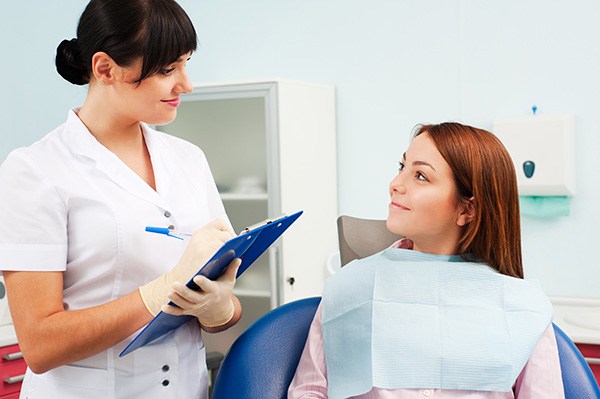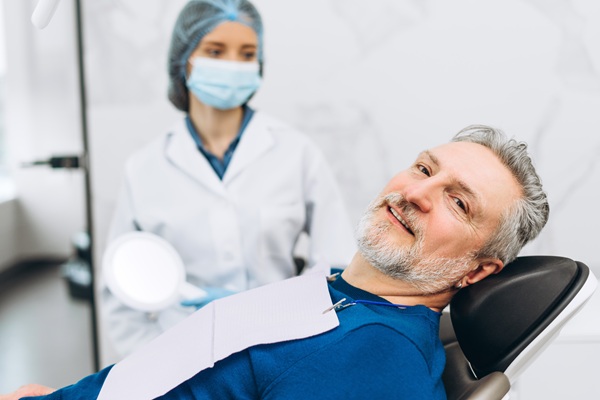What a Dentist Checks for During an Oral Cancer Screening

Wondering what happens during an oral cancer screening? All dentists are trained to complete visual oral cancer screenings by request. Some dentists recommend an oral cancer screening based on lifestyle choices or family history. These visual examinations can be completed in a matter of minutes, and can save lives. Early detection is vital in combating this destructive disease, and a simple screening can reassure a patient that may suspect cancer.
Oral cancer screenings should be requested by the patient (even if there are no apparent signs of the disease) at every dental checkup. Dentists will usually already be looking for symptoms and signs of oral cancer during a checkup, but it does not hurt to specifically ask for a screening. Oral cancer screenings should take place before any symptoms show.
What happens during an oral cancer screening
An oral cancer screening consists of two parts: a visual examination and a physical examination of the gums, palate, soft tissue and tongue. Examining the face, neck, lips and inside of the nose are other big parts of oral cancer screenings. Before the screening, the patient must remove all oral appliances, such as dentures and retainers. This helps to expose every possible area in the mouth that may be prone to oral cancer.
First, the dentist will look for asymmetries. Any swelling, bumps, lumps, white patches, sores, rough patches and other abnormalities will be examined, as well. The dentist will use a small light and mirror to look inside the nose and mouth. Using a tongue depressor, the dentist will examine the back of the throat.
In the physical exam, the dentist will touch the head and cheeks around the jaw, under the chin and inside the oral cavity. They will be looking for anything out of the ordinary. Unusual nodules or masses will be noted, and may need further examination.
One sign of oral cancer that is widely unknown is the inability to move normally mobile tissue. These spots usually cause pain when pressure is applied as well. However, not all cancerous areas will be painful.
In addition to a visual and physical exam, certain technological tools may be used. Oral cancer screening devices such as the VELscope can help the dentist to identify precancerous cells that are invisible to the naked eye. This device shines a safe blue light into the oral cavity. Normal tissue will illuminate, while precancerous or cancerous spots will remain dark.
If the dentist does find an abnormality during an oral cancer screening, a sample will likely be taken of the cells in question and sent out to the lab for a biopsy. Although oral cancer screenings can alert the dentist to possible problem areas, diagnosing the disease is much more involved.
Oral cancer screenings can save lives
Early detection is crucial in saving lives. If you have a family history of oral cancer or participate in certain habits such as tobacco use or excessive alcohol intake, you may be at a higher risk for developing oral cancer. If this is the case, you should request oral cancer screenings every four months.
Request an appointment here: https://smilesdental.com or call Smiles Dental Care at (650) 563-1180 for an appointment in our Mountain View office.
Check out what others are saying about our services on Yelp: Read our Yelp reviews.
Recent Posts
Do you think your wisdom teeth may need to be removed? Wisdom teeth extraction, whether complete or partial, is a standard procedure that comes by recommendation of a dentist. Sometimes, it could be because they were coming in crooked or placing too much strain on your jaw or neighboring teeth. If you have undergone a…
An in-office professional dental cleaning is a crucial aspect of maintaining good oral health. While oral hygiene done at home is a great way to keep the teeth and gums healthy, it is important to see a general dentist on a regular basis for cleanings and examinations. Dental cleanings are simple, easy, and relatively painless,…
In general dentistry, cracked teeth are, unfortunately, a common problem that requires attention. Thankfully, modern-day dentistry has created a few different options that can solve the problem of a cracked tooth. In most situations, a general dentist can salvage a cracked tooth; however, it is important to know that there are a few factors that…
Dental implant surgery involves the replacement of missing teeth with a surgically inserted metal post. This oral surgery is becoming increasingly popular every passing day. If you are considering dental implants, you will need oral surgery. You should prepare early for the procedures that may be involved.A patient may need oral surgery to resolve problems…


